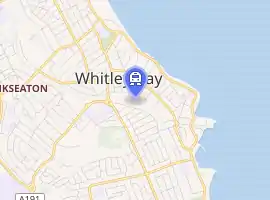Whitley Bay Metro station
Whitley Bay is a station on the Tyne and Wear Metro, serving the Whitley Bay area of North Tyneside. The Tyne and Wear Metro station at Whitley Bay was opened in August 1980.
Whitley Bay | |||||||||||
|---|---|---|---|---|---|---|---|---|---|---|---|
| Tyne and Wear Metro station | |||||||||||
 | |||||||||||
| Location | Whitley Bay, North Tyneside England | ||||||||||
| Coordinates | 55°02′24″N 1°26′34″W | ||||||||||
| Grid reference | NZ357718 | ||||||||||
| Transit authority | Tyne and Wear Passenger Transport Executive | ||||||||||
| Platforms | 2 | ||||||||||
| Tracks | 2 | ||||||||||
| Construction | |||||||||||
| Parking | 78 spaces | ||||||||||
| Bicycle facilities |
| ||||||||||
| Disabled access | Step-free access to platform level | ||||||||||
| Other information | |||||||||||
| Station code | WTL | ||||||||||
| Fare zone | C | ||||||||||
| History | |||||||||||
| Original company | North Eastern Railway | ||||||||||
| Pre-grouping | North Eastern Railway | ||||||||||
| Post-grouping | |||||||||||
| Key dates | |||||||||||
| 3 July 1882 | Opened as Whitley | ||||||||||
| 1 July 1899 | Renamed Whitley Bay | ||||||||||
| 9 October 1910 | Resited | ||||||||||
| 10 September 1979 | Closed for conversion | ||||||||||
| 11 August 1980 | Reopened | ||||||||||
| Passengers | |||||||||||
| 2017/18 | 0.53 million[1] | ||||||||||
| Services | |||||||||||
| |||||||||||
| Location | |||||||||||

| |||||||||||
The station is located in a residential area, and is a short walk from both the town centre and the beach, which attracts many of its passengers.
The station was used by approximately 530,000 passengers in 2017-18.
Station facilities include a café, cycle parking, and limited free car parking. There is also a bus stop (used by the W1, W1A & W2 routes), and a taxi rank outside the station.[2]
History
In 1860, the Blyth and Tyne Railway opened its line from Tynemouth to Dairy House Junction, south of the Northumbrian village of Hartley. The original station serving the town was named Whitley, and was located around 600 metres west of the present station site. However, this was only open for four years, being closed in 1864 and replaced by a station to the north, adjacent to present day Monkseaton station.[3][4]
In 1882, the North Eastern Railway opened its coastal route from Tynemouth to Monkseaton, replacing the inland Blyth and Tyne route, and a new station designed by William Bell was opened the same year, also called Whitley (this station being renamed Whitley Bay in 1899).[5][6]
From 1904, the station was served by the electric trains of the North Eastern Railway.[7] The electric services became so popular with people living in Whitley Bay and travelling to Newcastle to work, and also with those visiting the town for a day out or a holiday, that a new station became a necessity.[8] The new building opened in October 1910.[9][10] Architectural historian Nikolaus Pevsner later said of the building that it "(lends) some distinction to an undistinguished neighbourhood".[11]
The "Tyneside Electrics" were withdrawn by British Rail in 1967, and replaced by diesel multiple unit trains.[7] The diesel trains provided a slower service, and trains called at intervals of every 30 minutes instead of every 20, although a limited-stop express service also called every hour.[10]
In preparation for its second conversion to electric train operation, this time to join the Tyne and Wear Metro system, the station lost its services towards Newcastle via Monkseaton on 23 January 1978, and was closed completely on 10 September 1979. It reopened on 11 August 1980, the first day of Metro service.[12] The main changes involved in the station's conversion were shortening of the train shed at each end of the platforms and replacement of the original footbridge, with no further major changes having been made as of 2014. The station's main building and train shed were given Grade II listed building status in 1986.[13]
Service & Frequency

Whitley Bay is served by the Yellow Line (running from South Shields to Newcastle City Centre, Whitley Bay, Wallsend & St. James).
This line runs up to every 12 minutes during the day (Monday to Saturday), and up to every 15 minutes in the evenings and on a Sunday.
Station artwork
In 1983, the artwork Passing by Ian Patience was installed in the entrance hall to platform 2. It depicts a family on a day trip to the beach and also shows a nocturnal seascape in the central panel.[14]
References
- "Tyne & Wear Metro usage figures". 2017–2018. Retrieved 21 August 2019.
- "Whitley Bay - Nexus". Nexus. Retrieved 3 February 2014.
- "Disused Stations: Whitley (First site)". Disused Stations. Retrieved 8 March 2014.
- "Disused Stations: Monkseaton (First site)". Disused Stations. Retrieved 8 March 2014.
- M. Quick, Railway Passenger Stations in Great Britain - A Chronology. p. 410. Railway and Canal Historical Society, 2005. ISBN 978 0 901461 575.
- "Disused Stations: Whitley Bay (First site)". Disused Stations. Retrieved 8 March 2014.
- J.C Gillham, The Age of the Electric Train - Electric Trains in Britain since 1883, Ian Allan, 1988, p.36-7. ISBN 0 7110 1392 6
- G. Biddle, Britain's Historic Railway Buildings, Oxford University Press, 2003, p.396-7
- M. Quick, p. 410.
- "Disused Stations: Whitley Bay (Second site)". Disused Stations. Retrieved 8 March 2014.
- N. Pevsner et al, The Buildings of England: Northumberland. Yale University Press 2002, p.626.
- Quick, p.410
- Historic England. "Details from listed building database (1355007)". National Heritage List for England. Retrieved 8 March 2014.
- "'Passing' by Ian Patience". Nexus. Retrieved 3 February 2014.
External links
 Media related to Whitley Bay Metro station at Wikimedia Commons
Media related to Whitley Bay Metro station at Wikimedia Commons- Timetable and station information for Whitley Bay